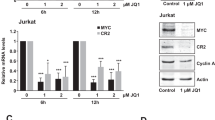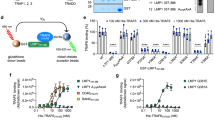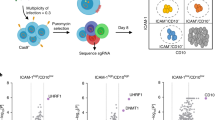Abstract
Epstein–Barr virus (EBV) contributes to the development of several human cancers including the endemic form of Burkitt's lymphoma (BL). In culture, EBV induces the continuous proliferation of primary B cells as lymphoblastoid cell lines (LCLs) and if EBV-negative BL-derived cells are infected with EBV, latency-associated viral factors confer resistance to various inducers of apoptosis. Nuclear proteins EBNA3A and EBNA3C (but not EBNA3B) are necessary to establish LCLs and their expression may be involved in the resistance of BL cells to cytotoxic agents. We have therefore created recombinant EBVs from which each of the EBNA3 genes has been independently deleted, and revertant viruses in which the genes have been re-introduced into the viral genome. Infection of EBV-negative BL cells with this panel of EBVs and challenge with various cytotoxic drugs showed that EBNA3A and EBNA3C cooperate as the main determinants of both drug resistance and the downregulation of the proapoptotic Bcl-2-family member Bcl-2-interacting mediator of cell death (Bim). The regulation of Bim is predominantly at the level of RNA, with little evidence of post-translational Bim stabilization by EBV. In the absence of Bim, EBNA3A and EBNA3C appear to provide no survival advantage. The level of Bim is a critical regulator of B cell survival and reduced expression is a major determinant of lymphoproliferative disease in mice and humans; moreover, Bim is uniquely important in the pathogenesis of BL. By targeting this tumour-suppressor for repression, EBV significantly increases the likelihood of B lymphomagenesis in general, and BL in particular. Our results may also explain the selection pressure that gives rise to a subset of BL that retain expression of the EBNA3 proteins.
This is a preview of subscription content, access via your institution
Access options
Subscribe to this journal
Receive 50 print issues and online access
$259.00 per year
only $5.18 per issue
Buy this article
- Purchase on SpringerLink
- Instant access to full article PDF
Prices may be subject to local taxes which are calculated during checkout






Similar content being viewed by others
Abbreviations
- BL:
-
Burkitt's lymphoma
- EBNA:
-
Epstein–Barr virus nuclear antigen
- LCL:
-
lymphoblastoid cell line
References
Allday MJ, Sinclair A, Parker G, Crawford DH, Farrell PJ . (1995). Epstein–Barr virus efficiently immortalizes human B cells without neutralizing the function of p53. EMBO J 14: 1382–1391.
Alvi AJ, Austen B, Weston VJ, Fegan C, MacCallum D, Gianella-Borradori A et al. (2005). A novel CDK inhibitor, CYC202 (R-roscovitine), overcomes the defect in p53-dependent apoptosis in B-CLL by down-regulation of genes involved in transcription regulation and survival. Blood 105: 4484–4491.
Bain M, Watson RJ, Farrell PJ, Allday MJ . (1996). Epstein-Barr virus nuclear antigen 3C is a powerful repressor of transcription when tethered to DNA. J Virol 70: 2481–2489.
Bornkamm GW, Hammerschmidt W . (2001). Molecular virology of Epstein-Barr virus. Philos Trans R Soc Lond B Biol Sci 356: 437–459.
Bouillet P, Metcalf D, Huang DC, Tarlinton DM, Kay TW, Kontgen F et al. (1999). Proapoptotic Bcl-2 relative Bim required for certain apoptotic responses, leukocyte homeostasis, and to preclude autoimmunity. Science 286: 1735–1738.
Bourillot PY, Waltzer L, Sergeant A, Manet E . (1998). Transcriptional repression by the Epstein-Barr virus EBNA3A protein tethered to DNA does not require RBP-Jkappa. J Gen Virol 79 (Part 2): 363–370.
Calender A, Billaud M, Aubry JP, Banchereau J, Vuillaume M, Lenoir GM . (1987). Epstein-Barr virus (EBV) induces expression of B-cell activation markers on in vitro infection of EBV-negative B-lymphoma cells. Proc Natl Acad Sci USA 84: 8060–8064.
Chinnadurai G . (2002). CtBP, an unconventional transcriptional corepressor in development and oncogenesis. Mol Cell 9: 213–224.
Cludts I, Farrell PJ . (1998). Multiple functions within the Epstein-Barr virus EBNA-3A protein. J Virol 72: 1862–1869.
Clybouw C, McHichi B, Mouhamad S, Auffredou MT, Bourgeade MF, Sharma S et al. (2005). EBV infection of human B lymphocytes leads to down-regulation of Bim expression: relationship to resistance to apoptosis. J Immunol 175: 2968–2973.
Dang CV, O’Donnell KA, Juopperi T . (2005). The great MYC escape in tumorigenesis. Cancer Cell 8: 177–178.
Delecluse HJ, Hilsendegen T, Pich D, Zeidler R, Hammerschmidt W . (1998). Propagation and recovery of intact, infectious Epstein-Barr virus from prokaryotic to human cells. Proc Natl Acad Sci USA 95: 8245–8250.
Egle A, Harris AW, Bouillet P, Cory S . (2004). Bim is a suppressor of Myc-induced mouse B cell leukemia. Proc Natl Acad Sci USA 101: 6164–6169.
Epeldegui M, Hung YP, McQuay A, Ambinder RF, Martinez-Maza O . (2007). Infection of human B cells with Epstein-Barr virus results in the expression of somatic hypermutation-inducing molecules and in the accrual of oncogene mutations. Mol Immunol 44: 934–942.
Essafi A, Fernandez de Mattos S, Hassen YA, Soeiro I, Mufti GJ, Thomas NS et al. (2005). Direct transcriptional regulation of Bim by FoxO3a mediates STI571-induced apoptosis in Bcr-Abl-expressing cells. Oncogene 24: 2317–2329.
Finke J, Rowe M, Kallin B, Ernberg I, Rosen A, Dillner J et al. (1987). Monoclonal and polyclonal antibodies against Epstein-Barr virus nuclear antigen 5 (EBNA-5) detect multiple protein species in Burkitt's lymphoma and lymphoblastoid cell lines. J Virol 61: 3870–3878.
Fruehling S, Lee SK, Herrold R, Frech B, Laux G, Kremmer E et al. (1996). Identification of latent membrane protein 2A (LMP2A) domains essential for the LMP2A dominant-negative effect on B-lymphocyte surface immunoglobulin signal transduction. J Virol 70: 6216–6226.
Hemann MT, Bric A, Teruya-Feldstein J, Herbst A, Nilsson JA, Cordon-Cardo C et al. (2005). Evasion of the p53 tumour surveillance network by tumour-derived MYC mutants. Nature 436: 807–811.
Henderson S, Rowe M, Gregory C, Croom-Carter D, Wang F, Longnecker R et al. (1991). Induction of bcl-2 expression by Epstein-Barr virus latent membrane protein 1 protects infected B cells from programmed cell death. Cell 65: 1107–1115.
Hickabottom M, Parker GA, Freemont P, Crook T, Allday MJ . (2002). Two nonconsensus sites in the Epstein-Barr virus oncoprotein EBNA3A cooperate to bind the co-repressor carboxyl-terminal-binding protein (CtBP). J Biol Chem 277: 47197–47204.
Jimenez-Ramirez C, Brooks AJ, Forshell LP, Yakimchuk K, Zhao B, Fulgham TZ et al. (2006). Epstein-Barr virus EBNA-3C is targeted to and regulates expression from the bidirectional LMP-1/2B promoter. J Virol 80: 11200–11208.
Kaiser C, Laux G, Eick D, Jochner N, Bornkamm GW, Kempkes B . (1999). The proto-oncogene c-myc is a direct target gene of Epstein-Barr virus nuclear antigen 2. J Virol 73: 4481–4484.
Kelly GL, Milner AE, Baldwin GS, Bell AI, Rickinson AB . (2006). Three restricted forms of Epstein-Barr virus latency counteracting apoptosis in c-myc-expressing Burkitt lymphoma cells. Proc Natl Acad Sci USA 103: 14935–14940.
Kelly GL, Milner AE, Tierney RJ, Croom-Carter DS, Altmann M, Hammerschmidt W et al. (2005). Epstein-Barr virus nuclear antigen 2 (EBNA2) gene deletion is consistently linked with EBNA3A, -3B, and -3C expression in Burkitt's lymphoma cells and with increased resistance to apoptosis. J Virol 79: 10709–10717.
Knight JS, Lan K, Subramanian C, Robertson ES . (2003). Epstein-Barr virus nuclear antigen 3C recruits histone deacetylase activity and associates with the corepressors mSin3A and NCoR in human B-cell lines. J Virol 77: 4261–4272.
Laherty CD, Hu HM, Opipari AW, Wang F, Dixit VM . (1992). The Epstein-Barr virus LMP1 gene product induces A20 zinc finger protein expression by activating nuclear factor kappa B. J Biol Chem 267: 24157–24160.
Leao M, Anderton E, Wade M, Meekings K, Allday MJ . (2007). Epstein-Barr virus-induced resistance to drugs that activate the mitotic spindle assembly checkpoint in Burkitt's lymphoma cells. J Virol 81: 248–260.
Ley R, Balmanno K, Hadfield K, Weston C, Cook SJ . (2003). Activation of the ERK1/2 signaling pathway promotes phosphorylation and proteasome-dependent degradation of the BH3-only protein, Bim. J Biol Chem 278: 18811–18816.
Lindstrom MS, Klangby U, Wiman KG . (2001). p14ARF homozygous deletion or MDM2 overexpression in Burkitt lymphoma lines carrying wild type p53. Oncogene 20: 2171–2177.
Mestre-Escorihuela C, Rubio-Moscardo F, Richter JA, Siebert R, Climent J, Fresquet V et al. (2007). Homozygous deletions localize novel tumor suppressor genes in B-cell lymphomas. Blood 109: 271–280.
O’Nions J, Allday MJ . (2003). Epstein-Barr virus can inhibit genotoxin-induced G1 arrest downstream of p53 by preventing the inactivation of CDK2. Oncogene 22: 7181–7191.
O’Nions J, Allday MJ . (2004). Deregulation of the cell cycle by the Epstein-Barr virus. Adv Cancer Res 92: 119–186.
O’Nions J, Turner A, Craig R, Allday MJ . (2006). Epstein-Barr virus selectively deregulates DNA damage responses in normal B cells but has no detectable effect on regulation of the tumor suppressor p53. J Virol 80: 12408–12413.
O’Reilly LA, Cullen L, Visvader J, Lindeman GJ, Print C, Bath ML et al. (2000). The proapoptotic BH3-only protein bim is expressed in hematopoietic, epithelial, neuronal, and germ cells. Am J Pathol 157: 449–461.
Radkov SA, Touitou R, Brehm A, Rowe M, West M, Kouzarides T et al. (1999). Epstein-Barr virus nuclear antigen 3C interacts with histone deacetylase to repress transcription. J Virol 73: 5688–5697.
Rosendorff A, Illanes D, David G, Lin J, Kieff E, Johannsen E . (2004). EBNA3C coactivation with EBNA2 requires a SUMO homology domain. J Virol 78: 367–377.
Shi Y, Sawada J, Sui G, Affar el B, Whetstine JR, Lan F et al. (2003). Coordinated histone modifications mediated by a CtBP co-repressor complex. Nature 422: 735–738.
Strasser A . (2005). The role of BH3-only proteins in the immune system. Nat Rev Immunol 5: 189–200.
Tagawa H, Karnan S, Suzuki R, Matsuo K, Zhang X, Ota A et al. (2005). Genome-wide array-based CGH for mantle cell lymphoma: identification of homozygous deletions of the proapoptotic gene BIM. Oncogene 24: 1348–1358.
Tan TT, Degenhardt K, Nelson DA, Beaudoin B, Nieves-Neira W, Bouillet P et al. (2005). Key roles of BIM-driven apoptosis in epithelial tumors and rational chemotherapy. Cancer Cell 7: 227–238.
Tomkinson B, Robertson E, Kieff E . (1993). Epstein-Barr virus nuclear proteins EBNA-3A and EBNA-3C are essential for B-lymphocyte growth transformation. J Virol 67: 2014–2025.
Touitou R, Hickabottom M, Parker G, Crook T, Allday MJ . (2001). Physical and functional interactions between the corepressor CtBP and the Epstein-Barr virus nuclear antigen EBNA3C. J Virol 75: 7749–7755.
Wade M, Allday MJ . (2000). Epstein-Barr virus suppresses a G(2)/M checkpoint activated by genotoxins. Mol Cell Biol 20: 1344–1360.
White RE, Calderwood MA, Whitehouse A . (2003). Generation and precise modification of a herpesvirus saimiri bacterial artificial chromosome demonstrates that the terminal repeats are required for both virus production and episomal persistence. J Gen Virol 84: 3393–3403.
Young LS, Rickinson AB . (2004). Epstein-Barr virus: 40 years on. Nat Rev Cancer 4: 757–768.
Zimber-Strobl U, Strobl LJ . (2001). EBNA2 and Notch signalling in Epstein-Barr virus mediated immortalization of B lymphocytes. Semin Cancer Biol 11: 423–434.
Acknowledgements
We thank the Wellcome Trust and the Medical Research Council, UK, for financial support of this research.
Author information
Authors and Affiliations
Corresponding author
Additional information
Supplementary Information accompanies the paper on the Oncogene website (http://www.nature.com/onc).
Rights and permissions
About this article
Cite this article
Anderton, E., Yee, J., Smith, P. et al. Two Epstein–Barr virus (EBV) oncoproteins cooperate to repress expression of the proapoptotic tumour-suppressor Bim: clues to the pathogenesis of Burkitt's lymphoma. Oncogene 27, 421–433 (2008). https://doi.org/10.1038/sj.onc.1210668
Received:
Revised:
Accepted:
Published:
Issue Date:
DOI: https://doi.org/10.1038/sj.onc.1210668
Keywords
This article is cited by
-
T-cell receptor signal strength and epigenetic control of Bim predict memory CD8+ T-cell fate
Cell Death & Differentiation (2020)
-
EBV BCL-2 homologue BHRF1 drives chemoresistance and lymphomagenesis by inhibiting multiple cellular pro-apoptotic proteins
Cell Death & Differentiation (2020)
-
Coordinated repression of BIM and PUMA by Epstein–Barr virus latent genes maintains the survival of Burkitt lymphoma cells
Cell Death & Differentiation (2018)
-
Post-transplant lymphoproliferative disorders
Nature Reviews Disease Primers (2016)
-
Epstein–Barr virus: more than 50 years old and still providing surprises
Nature Reviews Cancer (2016)



